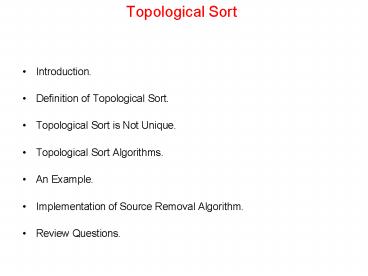Topological Sort - PowerPoint PPT Presentation
Title:
Topological Sort
Description:
Topological Sort Algorithms. An Example. Implementation of Source Removal Algorithm. ... ordering of V such that for any edge (u, v), u comes before v in. the ... – PowerPoint PPT presentation
Number of Views:2137
Avg rating:3.0/5.0
Title: Topological Sort
1
Topological Sort
- Introduction.
- Definition of Topological Sort.
- Topological Sort is Not Unique.
- Topological Sort Algorithms.
- An Example.
- Implementation of Source Removal Algorithm.
- Review Questions.
2
Introduction
- There are many problems involving a set of tasks
in which some of the tasks must be done before
others. - For example, consider the problem of taking a
course only after taking its prerequisites. - Is there any systematic way of linearly arranging
the courses in the order that they should be
taken?
Yes! - Topological sort.
3
What is a DAG?
- A directed acyclic graph (DAG) is a directed
graph without cycles. - DAGs arrise in modeling many problems that
involve prerequisite constraints (construction
projects, course prerequisites, document version
control, compilers, etc.) - Some properties of DAGs
- Every DAG must have at least one vertex with
in-degree zero and at least one vertex with
out-degree zero
Example
4
Definition of Topological Sort
- Given a directed graph G (V, E) a topological
sort of G is an - ordering of V such that for any edge (u, v),
u comes before v in - the ordering.
- Example1
- Example2
5
Definition of Topological Sort
- Example3 The graph in (a) can be topologically
sorted as in (b)
(a)
(b)
6
Topological Sort is not unique
- Topological sort is not unique.
- The following are all topological sort of the
graph below
7
Topological Sort Algorithms DFS based algorithm
Topological-Sort(G) 1. Call dfsAllVertices on G
to compute fv for each vertex v 2. If G
contains a back edge (v, w) (i.e., if fw gt
fv) , report error 3. else, as each vertex is
finished prepend it to a list // or push in
stack 4. Return the list // list is a valid
topological sort
- Running time is O(VE), which is the running
time for DFS.
Topological order A C D B E H F G
8
Topological Sort Algorithms Source Removal
Algorithm
- The Source Removal Topological sort algorithm is
- Pick a source u vertex with in-degree zero,
output it. - Remove u and all edges out of u.
- Repeat until graph is empty.
int topologicalOrderTraversal( ) int
numVisitedVertices 0 while(there are more
vertices to be visited) if(there is no
vertex with in-degree 0) break
else select a vertex v that has in-degree
0 visit v numVisitedVertices delete v
and all its emanating edges
return numVisitedVertices
9
Topological Sort Source Removal Example
- The number beside each vertex is the in-degree of
the vertex at the start of the algorithm.
10
Implementation of Topological Sort
- The algorithm is implemented as a traversal
method that visits the vertices in a topological
sort order. - An array of length V is used to record the
in-degrees of the vertices. Hence no need to
remove vertices or edges. - A priority queue is used to keep track of
vertices with in-degree zero that are not yet
visited.
public int topologicalOrderTraversal(Visitor
visitor) int numVerticesVisited 0 int
inDegree new intnumberOfVertices for(int
i 0 i lt numberOfVertices i)
inDegreei 0 Iterator p getEdges()
while (p.hasNext()) Edge edge (Edge)
p.next() Vertex to edge.getToVertex()
inDegreegetIndex(to)
11
Implementation of Topological Sort
- BinaryHeap queue new BinaryHeap(numberOfVerti
ces) - p getVertices()
- while(p.hasNext())
- Vertex v (Vertex)p.next()
- if(inDegreegetIndex(v) 0)
- queue.enqueue(v)
- while(!queue.isEmpty() !visitor.isDone())
- Vertex v (Vertex)queue.dequeueMin()
- visitor.visit(v)
- numVerticesVisited
- p v.getSuccessors()
- while (p.hasNext())
- Vertex to (Vertex) p.next()
- if(--inDegreegetIndex(to) 0)
- queue.enqueue(to)
12
Review Questions
- List the order in which the nodes of the directed
graph GB are visited by - topological order traversal that starts
from vertex a. Use both DFS-based and Source
Removal algorithm - 2. What kind of DAG has a unique topological
sort? - 3. Generate a directed graph using the
required courses for your major. Now apply
topological sort on the directed graph you
obtained.

